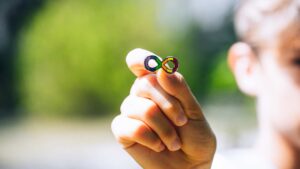Since the determination of an autism spectrum disorder (ASD) and diagnosis, people have theorized the possibility of an autism cure. The notion is as old as autism, formed before anyone truly understood the condition. Today, that thinking is considered archaic.
Autism is not a disease. Compassion, patience, and care are the only ways to manage the condition successfully. With the advent of brain scanning and human genome mapping, science has made strides in understanding the circumstances. However, “autism cure” is a misnomer because there is nothing to cure.
Autism, as a developmental condition, is highly complex. It exists on a spectrum and manifests differently from person to person. Some experience severe autism, as determined by such symptoms as being nonverbal and exhibiting developmental delays that impact every facet of their lives. For others, it’s hardly noticeable beyond a few preferences and conversational methods that make communication more challenging. Every person with autism is unique.
At ABA Centers of Virginia, our mission is to understand autism and provide the best therapy so neurodivergent individuals can overcome challenges. To accomplish this, we pride ourselves on staying informed with all scientific developments and best practices for care. The following blog addresses what we can do to make the lives of those on the spectrum easier and why it’s counterproductive to focus on an autism cure.
Can We Cure What Causes Autism?
There is no cookie-cutter answer for what causes autism, as there are complicated symptoms within a spectrum condition. ASD affects how someone thinks, acts, shows interests, interacts with others, grooms, and learns. Someone with ASD might only display mild problems making eye contact or fixating on a narrow topic. These behaviors differ significantly from a child who cannot speak without serious therapy.
Despite the spectrum’s complexity, studies have determined common reasons for the condition in children and newborns.
- Heritability: Studies of twins show that heritability (inheriting the disorder from a parent) is one of the primary determining factors of ASD. The heritability of autism is anywhere from 60-90 percent and seems to be the primary reason behind the autism diagnosis.
- Genetic Mutations: It’s not as simple as ASD due to hereditary genetics, as sometimes autism manifests with no family history. Scientists have remarked on a pattern where the chance of autism increases with the father’s age. The underlying reason might be genetic mutations in the father’s sperm, which increase as the father matures.
- Post-natal Contributors: For many, the hereditary and genetic components of autism are difficult to comprehend. These underlying causes are not readily observable or in our control. Some have turned to explanations like autoimmune conditions, pre-natal gastrointestinal issues, and vaccinations as causes of autism in infants. Many theories lack scientific backing, are purely anecdotal, or stem from falsified evidence.
- Environmental Factors: With an endlessly complex condition like ASD, one can’t leave out potential factors in the environment contributing to the development of the disorder. Studies have focused on lead and mercury, dangerous pesticides, and ubiquitous plastics. Additional causes considered are sleep apnea-induced oxygen shortage during pregnancy, diabetes, and the use of psychiatric drugs.
Why is an Autism Cure a Myth?
The very idea of an autism cure implies those with ASD are somehow defective and requires fixing, which can be offensive to some. The search for such a cure has been counterproductive, although it has brought us closer to understanding the condition. Regardless, it has led desperate parents down the path of unhelpful speculation.
A key reason why an autism cure does not (nor is it ever likely to) exist is because of how autism works in the brain. Developments in brain scanning technology show that neurodivergent brains have atypical development, with some areas seeing less neuron activation and others seeing more. Additionally, there are over 1000 genes that interact with autism, and we discover more every year. Some of the genes that may have a bearing on being born with ASD are:
- CHD8: This gene is essential in brain development and expression.
- CNTNAP2: This gene may explain why individuals with ASD struggle with communication and expression, as it helps synapses develop language skills.
- NRXN1: This is another gene that codes proteins for synapses.
- SHANK3: This gene is the leading candidate for indicating the presence of autism. It has the information to create a protein that establishes and upkeeps synapses (which connect neurons in the brain). This connection issue may explain the sensory problems individuals on the spectrum experience.
- TSC1 and TSC2: These genes are pivotal at all points in life, as they aid with cell growth and cell division.
It can be tempting to assume that from this, we understand autism and are close to a “cure.” But what scientists know is the general function of these genes and how they correlate with ASD. Their exact purpose, interaction with ASD, how the presence of one impacts the development or the expression of another, and thousands of other micro-interactions that might affect the onset of ASD (such as environmental factors) are beyond current knowledge. Brain mapping and genetics are new fields. Although we may understand more one day, nothing resembles a treatment to prevent autism.
How Does ABA Therapy Help with Autism?
ABA therapy focuses on positive reinforcement, incentivizing individuals on the spectrum to learn healthier coping mechanisms and rewarding them for making positive strides.
ABA has remained the most successful and extensively peer-reviewed therapy, covered by many insurances and recognized by the FDA.
While the concept of a cure is erroneous, therapy for the difficulties faced by those on the spectrum is beneficial. Applied Behavior Analysis (ABA) is the gold standard in autism care. It can teach individuals with ASD enduring skills that help them in all facets of life, from interpersonal relationships to academic growth to career advancement and eventual independence.
ABA Centers of Virginia and Autism
No matter the challenges your child is facing with ASD, we provide them with everything they need to grow and live their best life. Our certified ABA experts have the patience, compassion, and experience to craft a personalized plan of care that reinforces critical skills for development. With our focus on play therapy, we can make your child feel safe and discover abilities they never knew they had.
Call (855) 957-1892 or visit our website to discover how to make a difference in the life of someone you love.







